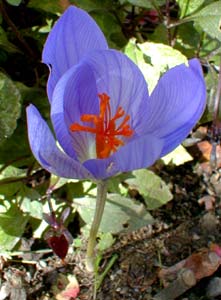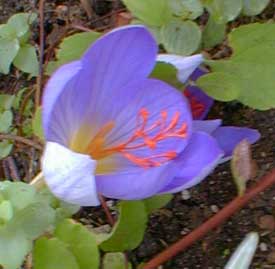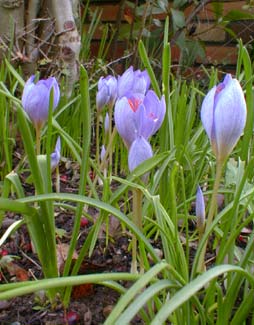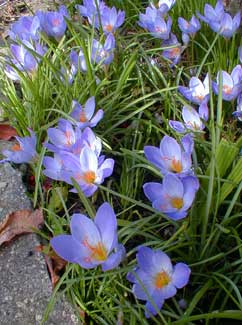
Showy Autumn Crocus;
or, Wild Fall Crocus
Well I call to mind
('Twas at an early age, ere I had seen
Nine summers) when upon the mountain slope
The frost & breath of frosty wind had snapp'd
The last autumnal crocus, 'twas my joy
To wander half the night among the Cliffs
And the smooth Hollows, where the woodcocks ran
Along the open turf.
"The Prelude: Childhood"
William Wordsworth (1770-1850)
William Wordsworth (1770-1850)
In 2002 we planted corms of the wild form Autumn Crocus, clones of C. speciosus ssp speciosus, or Showy Fall Crocus, a recipient of the Award of Garden Merit. The corms were planted in a sunny area between a Weeping Green Beech & a native Spiraea densiflora Rosy Spirea, a few lower leaves of which have embraced the Showy Crocus in the October close-up portrait at top of page.
 If planted in August, they will bloom even their first year, in October. Their first year in our garden (2002), they were gotten in the ground late (in September), yet even so sprang up rapidly & bloomed by late October & continued clear through November. The second year, they were well-up as buds before September's end & in fullest bloom throughout of October, lingering less impressively to the end of November. The photos on this page were snapped in October 2003; the blooms were perhaps twice the size they had been the first year.
If planted in August, they will bloom even their first year, in October. Their first year in our garden (2002), they were gotten in the ground late (in September), yet even so sprang up rapidly & bloomed by late October & continued clear through November. The second year, they were well-up as buds before September's end & in fullest bloom throughout of October, lingering less impressively to the end of November. The photos on this page were snapped in October 2003; the blooms were perhaps twice the size they had been the first year.The floppy habit of C. speciosus specisosus was identical to C. speciosus 'Conqueror' obtained from the same bulb specialist. These two varieties of the species do not show any particular distinct difference, except 'Conqueror' in its second year had so much longer stem-like tubes behind the flowers that they were weirdly tall for crocuses, hence even floppier. Both have orange-scarlet stigma & yellow anthers inside blue trumpets, & both are slow to open entirely, hiding their yellow interior parts for some while with petals closed tight & resembling snakes with thin white bodies & purple heads. The catalog promised 'Conqueror' was a deeper sky blue, & 'Showy' had darker blue lines, but you'd be hard pressed to tell much if any difference.
In our garden 'Showy' begins blooming about two weeks earlier than 'Conqueror' & lasts two weeks longer, so for extending bloom presence, it is nice to use multiple cultivars even if they are physically not noticeably different from one another.
 If these were in their first year disappointing, this was exclusively because we hadn't been warned, nor done sufficient research to realize, that they would fall over without a carefully chosen bracing companion. But finding such a perfect companion is no cinch.
If these were in their first year disappointing, this was exclusively because we hadn't been warned, nor done sufficient research to realize, that they would fall over without a carefully chosen bracing companion. But finding such a perfect companion is no cinch.That first year, it was just so tragic to see them bloom arrive so bright in autumn, only to fall over almost as soon as they were fully opened. Any that lay entirely on the ground were quickly eaten by critters in the soil, or were mushed by rainfall.
In preparation for their 2003 autumn bloom, hoping to repair the problems experienced the first year, we added to the area some evergreen turf of flowering Society Garlics & a semi-evergreen creeping groundcover of 'Kent Beauty' Oregano. Gorgeous though these additional plants proved to be for their own sake, they were insufficient as bracing companions, as the Society Garlic remained a fairly tight clump rather than a ground cover, & the 'Kent Beauty' trails about the ground so thinly & coujld only brace a couple random crocus flowers while the majority continued to flop.
A couple dozen additional Showy Autumn Crocus bulbs were placed in an old established patch of Muscari botryoides, shown in October bloom in the third & fourth photos. These were still going gung-ho perfect in November after a solid week of frosty mornings. They bloomed all told for a full two months & there were a few decreasingly spectacular blooms even in early December. No other crocus of my experience has bloomed so long, neither autumn nor winter, though the one that comes closest to such a lengthy bloom time is C. pulchellis, the Balkans autumn crocus very closely related to C. speciosus.
 The Grape Hyacinths, though not blooming until spring, produce rich green autumn grass before its time for the Autumn Crocuses to bloom. Of my attempted bracing companions for the floppy crocuses, M. botryoides has been the only one that was a real success. This Grape Hyacinth is so aggressive that in the long run it might keep the Autumn Crocus from fully naturalizing. Only time will tell if they can be good long-term companions, but so far, in our zone, they appear to be the perfect partners.
The Grape Hyacinths, though not blooming until spring, produce rich green autumn grass before its time for the Autumn Crocuses to bloom. Of my attempted bracing companions for the floppy crocuses, M. botryoides has been the only one that was a real success. This Grape Hyacinth is so aggressive that in the long run it might keep the Autumn Crocus from fully naturalizing. Only time will tell if they can be good long-term companions, but so far, in our zone, they appear to be the perfect partners.On the other side of the house meanwhile, the 'Conqueror' variety was tried with an evergreen Oregon Oxalis & Dwarf Variegated Marjoram, but I failed to realize this variety would have tubes ten inches long when mature in their second year; no catalog description said they could get that tall, & no crocus I ever before planted was so tall. The bracing companions proved to be poor choices because the crocus blooms shot upward & just fell right over on top of the groundcovers.
Really only the ones planted in the muscari grass did super well, remaining upright through their long period of bloom. Despite a lot of kvetching about the other patches, to whatever degree they failed in our yard, this was because we did not quite know the best way to plant them, & I'm most certainly not willing to give up on the idea that this will be repaired for coming years.
The positives about Autumn Crocuses are, first & foremost, the long bloom-time that brings such lovely violet-blue tubular goblets to the garden late in the year when fewer & fewer things are blooming. Then there is their ease of naturalizing so that they needn't be replanted again. And not having to wait long to see them the first autumn they were planted was an immediate bonus.
Even the great crocus enthusiast A. E. Bowles confessed he had never found the perfect companion to keep them from flopping, but if this problem can be moderately ameliorated, the showiness of the flowers is worth the effort. I can't boast of having solved a dilemma even Bowles could not fully solve, because I do not yet know if the effective use of the autumn-grassing muscari will permit the crocus bulbs to naturalize in the long run. But for our zone & garden conditions, it seems thus far a perfect solution. I don't want to put muscaris every single place I could have the autumn crocuses, however, so I still need to find other equally effective companions to uphold the floppy blooms, & a spreading groundcovers that are either evergreen or still very sturdy in late autumn are the plants to consider.
This crocus is native of southern Europe to Asia Minor including the Caucasus, northern Turkey & Iran. Hardy down to zone 3. they like rich loamy soil, well drained, in a sunny spot, but will tolerate a bit of shade.